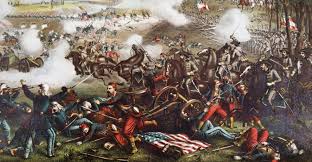Civil War – History Notes On – W.B.C.S. Examination.
গৃহযুদ্ধ – ইতিহাসের নোট – WBCS পরীক্ষা।
The Civil War in the United States began in 1861, after decades of simmering tensions between northern and southern states over slavery, states’ rights and westward expansion. The election of Abraham Lincoln in 1860 caused seven southern states to secede and form the Confederate States of America; four more states soon joined them. The War Between the States, as the Civil War was also known, ended in Confederate surrender in 1865. The conflict was the costliest and deadliest war ever fought on American soil, with some 620,000 of 2.4 million soldiers killed, millions more injured and much of the South left in ruin.Continue Reading Civil War – History Notes On – W.B.C.S. Examination.
In the mid-19th century, while the United States was experiencing an era of tremendous growth, a fundamental economic difference existed between the country’s northern and southern regions.
In the North, manufacturing and industry was well established, and agriculture was mostly limited to small-scale farms, while the South’s economy was based on a system of large-scale farming that depended on the labor of black slaves to grow certain crops, especially cotton and tobacco.
In 1854, the U.S. Congress passed the Kansas-Nebraska Act, which essentially opened all new territories to slavery by asserting the rule of popular sovereignty over congressional edict. Pro- and anti-slavery forces struggled violently in “Bleeding Kansas,” while opposition to the act in the North led to the formation of the Republican Party, a new political entity based on the principle of opposing slavery’s extension into the western territories. After the Supreme Court’s ruling in the Dred Scott case (1857) confirmed the legality of slavery in the territories, the abolitionist John Brown’s raid at Harper’s Ferry in 1859 convinced more and more southerners that their northern neighbors were bent on the destruction of the “peculiar institution” that sustained them. Lincoln’s election in November 1860 was the final straw, and within three months seven southern states–South Carolina, Mississippi, Florida, Alabama, Georgia, Louisiana and Texas–had seceded from the United States.
Even as Lincoln took office in March 1861, Confederate forces threatened the federal-held Fort Sumter in Charleston, South Carolina. On April 12, after Lincoln ordered a fleet to resupply Sumter, Confederate artillery fired the first shots of the Civil War. Sumter’s commander, Major Robert Anderson, surrendered after less than two days of bombardment, leaving the fort in the hands of Confederate forces under Pierre G.T. Beauregard. Four more southern states–Virginia, Arkansas, North Carolina and Tennessee–joined the Confederacy after Fort Sumter. Border slave states like Missouri, Kentucky and Maryland did not secede, but there was much Confederate sympathy among their citizens.
Though on the surface the Civil War may have seemed a lopsided conflict, with the 23 states of the Union enjoying an enormous advantage in population, manufacturing (including arms production) and railroad construction, the Confederates had a strong military tradition, along with some of the best soldiers and commanders in the nation. They also had a cause they believed in: preserving their long-held traditions and institutions, chief among these being slavery.
Meanwhile, exhausted by the Union siege of Petersburg and Richmond, Lee’s forces made a last attempt at resistance, attacking and captured the Federal-controlled Fort Stedman on March 25. An immediate counterattack reversed the victory, however, and on the night of April 2-3 Lee’s forces evacuated Richmond. For most of the next week, Grant and Meade pursued the Confederates along the Appomattox River, finally exhausting their possibilities for escape. Grant accepted Lee’s surrender at Appomattox Court House on April 9. On the eve of victory, the Union lost its great leader: The actor and Confederate sympathizer John Wilkes Booth assassinated President Lincoln at Ford’s Theatre in Washington on April 14. Sherman received Johnston’s surrender at Durham Station, North Carolina on April 26, effectively ending the Civil War.
Our own publications are available at our webstore (click here).
For Guidance of WBCS (Exe.) Etc. Preliminary , Main Exam and Interview, Study Mat, Mock Test, Guided by WBCS Gr A Officers , Online and Classroom, Call 9674493673, or mail us at – mailus@wbcsmadeeasy.in
Visit our you tube channel WBCSMadeEasy™ You tube Channel
Please subscribe here to get all future updates on this post/page/category/website



 Toll Free 1800 572 9282
Toll Free 1800 572 9282  mailus@wbcsmadeeasy.in
mailus@wbcsmadeeasy.in


















































































































